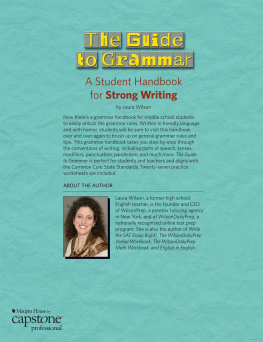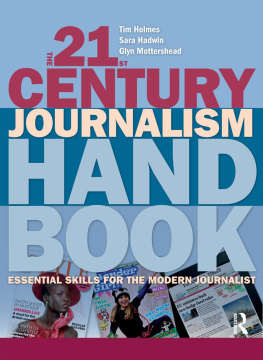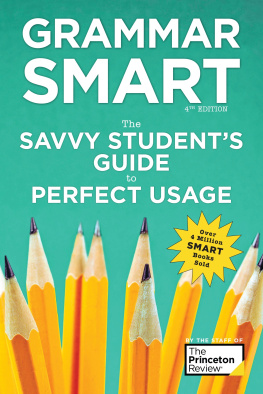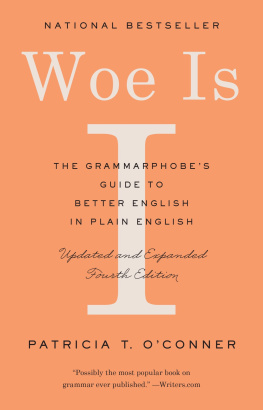Princeton Language Institute - 21st Century Grammar Handbook
Here you can read online Princeton Language Institute - 21st Century Grammar Handbook full text of the book (entire story) in english for free. Download pdf and epub, get meaning, cover and reviews about this ebook. year: 2010, publisher: Random House Publishing Group, genre: Home and family. Description of the work, (preface) as well as reviews are available. Best literature library LitArk.com created for fans of good reading and offers a wide selection of genres:
Romance novel
Science fiction
Adventure
Detective
Science
History
Home and family
Prose
Art
Politics
Computer
Non-fiction
Religion
Business
Children
Humor
Choose a favorite category and find really read worthwhile books. Enjoy immersion in the world of imagination, feel the emotions of the characters or learn something new for yourself, make an fascinating discovery.

- Book:21st Century Grammar Handbook
- Author:
- Publisher:Random House Publishing Group
- Genre:
- Year:2010
- Rating:4 / 5
- Favourites:Add to favourites
- Your mark:
- 80
- 1
- 2
- 3
- 4
- 5
21st Century Grammar Handbook: summary, description and annotation
We offer to read an annotation, description, summary or preface (depends on what the author of the book "21st Century Grammar Handbook" wrote himself). If you haven't found the necessary information about the book — write in the comments, we will try to find it.
21st Century Grammar Handbook — read online for free the complete book (whole text) full work
Below is the text of the book, divided by pages. System saving the place of the last page read, allows you to conveniently read the book "21st Century Grammar Handbook" online for free, without having to search again every time where you left off. Put a bookmark, and you can go to the page where you finished reading at any time.
Font size:
Interval:
Bookmark:

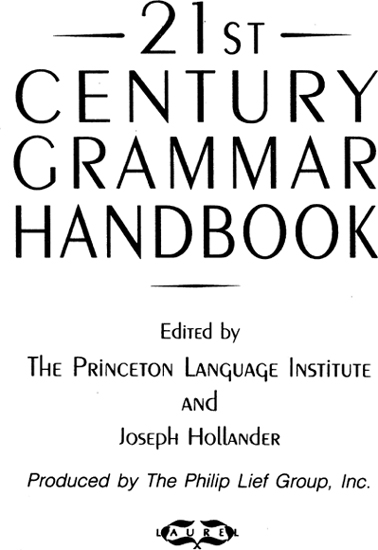
HOW DO YOU PUNCTUATE THIS?
The old wooden school desk lay in the corner and the small oak chair sat forlornly but proudly before the new computer station in the center of the classroom.
WHICH IS CORRECT?
Everyone should wear their seat belt.
Everyone should wear her or his seat belt.
WHAT IS WRONG WITH THIS SENTENCE?
Scratching and biting, the veterinarian gave the rabies shot to the owners cat.
DO YOU NEED AN APOSTROPHE?
In a democratic society, the peoples needs are respected.
FIND THE ANSWERS FAST.
ITS AS EASY AS ABC
WITH THE NEW DICTIONARY FORMAT
OF THE
21 ST CENTURY GRAMMAR HANDBOOK
The 21st Century Grammar Handbook is designed to give you direct and rapid answers to your questions about how to write or speak correctly. It is arranged like a dictionary: Its entries are in alphabetical order, covering not only grammar rules and examples of correct and incorrect usage but specific words or terms that often cause errors. It includes entries for be, is, am, are, was, and were, as well as the special names and terms used in English classrooms to analyze and categorize how these words work. The 21st Century Grammar Handbook is constructed to help you find solutions quickly and directly even if you dont know classroom grammar terminology.
You can also use the 21st Century Grammar Handbook to improve your writing and speaking overallto identify the areas in which you are weak or need pointers and then to find all the entries that will help.
To find answers to immediate problems you are having with your writing or speaking, simply look up the word or words that are bothering you. For example, to find out whether you should use who or whom, just look under who. You will discover right and wrong examples, an explanation of why the rules work the way they do, and suggestions for other entries to look at if you need more information.
But what if you know something is wrong but dont know exactly what the problem is or what it is called? Then look at the next section of this book: How to Know What You Dont Know. Here you will find a listing of the most common writing and speaking problems along with suggestions for places to look for answers. The list asks some questions that will help guide you to the places where your problems will be solved simply and swiftly.
If you dont find a match for your problem by looking through this section, then try to look up words that are similar to the ones that are causing you difficulty or that you think are okay in your sentence but that might be hiding errors: Look under and or is or that or comma or-ly or s. Then follow the suggestions for looking at related entries until you have identified whats wrong and how to fix it. If you still cant find what you dont know, try the entries on very broad topics like rules, style, bland writing, and similar subjects. There you will find not only specific answers to immediate problems but many hints about other areas you might consider to find the root of your difficulties.
If you do know the name of the grammar category or term with which you need help, you can look in the entries for the full citation and also find related entries on the subject that interests you.
To teach yourself better grammar and writing or speaking, first take the self-assessment quiz called How Good Are My Grammar, Writing, and Speaking? It will help you identify weak spots in your statements, places where tips and tricks will help make your writing or speaking stronger and more effective, and ways to avoid common pitfalls and take advantage of your stylistic strengths.
In each entry related subjects are highlighted in italic type. Examples are set off in quotation marks and clearly marked as RIGHT or WRONG.
This list contains the most common errors and confusions that beset writers and speakers. It is designed to highlight the most likely places for you to look for answers to your questions. Be sure to check entries for similar words or terms as well as for the things in your statement that seem correct to you but that might in fact be what is causing problems. Remember that the Handbook includes entries for general problems like bland writing, rules, and style. Each of these entries includes not only solutions to immediate problems but ideas about where else to look in the book for help or answers.
The list of topics to look at is not alphabetical for each problem but in order of where you are most likely to find specific answers to specific problems.
1. SPELLING: How do I know a word is spelled wrong? See spelling, dictionary, and languages.
2. RULES: Do I always have to follow them? See rules, style, dialect, grammar, and standard English.
3. RULES AGAIN: How do I know when Ive broken them? See editing, revision, and audience.
4. PUNCTUATION: Who cares? See comma, period, quotation mark, question mark, exclamation point, colon, semicolon, conjunction, clause, sentence, ellipsis, bracket, symbol, and hyphen.
5. VERBS: What are they, and how do I use them? See be, is, am, was, were, are, will, would, should, shall,tense, verbs, conjugation, clauses, agreement, and fragments.
6. PRONOUNS: When do I use who and whom or she and her? See the entries for the specific words as well as pronoun, personal pronoun, and the related grammatical listings.
7. NOUNS: What are they? See the entries for noun, proper noun, names, title, capitalization, and suggested related topics in those entries.
8. CONJUNCTIONS: How do parts of sentences get linked together? See the entries on conjunction; specific conjunctions like and; and parallelism, emphasis, clause, and so on.
9. MODIFIERS: Good and well drive me crazy. Look them up, along with adjective, adverb, comparison, and many other subjects.
10. CONFUSING WORDS: What is the difference between their and theyre and there? Look them up, and see the entry for homonym.
11. SEXIST AND OFFENSIVE LANGUAGE: When should I call a woman Ms. or Miss or Mrs.? All these words are listed, and there are entries on sexist language, titles of people, names, and many related subjects.
12. USING NUMBERS: Is it the 23rd Precinct or Twenty-third Precinct? Look under numbers, cardinal number, ordinal number, and related topics.
Mark any errors you find in the following sentences, each of which is numbered. The answers follow and are listed by the number of the sentence. Look for possible mistakes and whether your solutions are the right ones for making the sentence more accurate or better written. Other things to think about when you write or speak are noted as well. Be careful; there are some tricky things in the samples.
1. I didnt know who to give the book to.
2. She completed the operation, and then walked out of the operating room.
Font size:
Interval:
Bookmark:
Similar books «21st Century Grammar Handbook»
Look at similar books to 21st Century Grammar Handbook. We have selected literature similar in name and meaning in the hope of providing readers with more options to find new, interesting, not yet read works.
Discussion, reviews of the book 21st Century Grammar Handbook and just readers' own opinions. Leave your comments, write what you think about the work, its meaning or the main characters. Specify what exactly you liked and what you didn't like, and why you think so.

